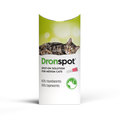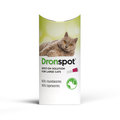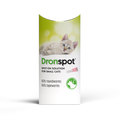When did you last worm your cat? Let’s face it. Giving worming tablets to cats can be stressful and before you know it those doses start to become less and less regular. Your cat looks healthy and it doesn’t seem like a problem…
But did you know that 1 in 4 cats in the UK were found to have intestinal worms? Many cats don’t show any signs of a worm infection, and if left untreated they can cause serious health complications like weight loss, vomiting, and diarrhoea.
Regular effective worming treatment is essential to help protect your cat from these unwanted invaders. In fact, it’s recommended that the majority of UK cats should be wormed monthly as they tend to spend time outdoors hunting and scavenging prey.
When it comes to choosing a worming treatment consider the effectiveness of the product and which parasites it treats, as well as your cat’s lifestyle and behaviour. Even the best worming treatment is only effective if it can be given to your cat regularly!
The most common types of worming products are tablets and spot-on treatments.
Spot-on treatments are liquids that are applied topically to the skin at the back of your cat’s neck. An example is Dronspot Wormer Spot On For Cats, clinically proven to treat every type of intestinal worm commonly found in UK cats.
The pros:
-
Most cat owners find applying spot-on treatments much easier than giving tablets
-
Just as fast-acting and effective as traditional worming tablets
-
Dronspot is suitable for use in kittens from 8 weeks of age and weighing over 500g, as well as adult cats of all sizes
The cons:
-
A small number of cats may experience itching and fur loss at the application site
-
Care should be taken as the product dries to ensure young children and other pets don’t touch the area. Regular cuddling can then resume as normal!
Tips for using spot-on worming treatments:
-
Apply the spot-on treatment high up on the back of the neck. This will stop your cat from turning around and licking the product off.
-
Spot-on products should only ever be applied externally to unbroken skin with no cuts, wounds, or scabs.
-
Though cats are much less likely to swim or receive baths, they shouldn’t get wet for the first 24-48 hours after application.
Worming tablets are best given directly into your cat’s mouth but may also be given with food.
The pros:
-
No wet patch
-
Just as fast-acting and effective as a spot-on worming treatment
The cons:
-
Many owners find giving their cat a tablet both difficult and stressful. Some cats will even bite or scratch, putting their owner at risk of injury
-
Cats are clever and will often avoid tablets, even those carefully hidden in food
-
A small number of cats may experience vomiting as a side effect, particularly those with sensitive stomachs
Tips for giving tablets:
-
Try hiding tablets in a small piece of meat or cheese. Easy-pilling pastes and putties are also available for this purpose.
-
Check the label to see if the tablet can be crushed or given with food.
-
A ‘pill-popper’ or ‘pill-giver’ can make tableting easier.
Regardless of which worming product you choose, make sure to weigh your cat so they receive the correct dose and offer them a treat as a reward afterwards. Remember that every cat is unique in how they react and respond to medication and it’s important to find an option that suits both of you so you can keep them protected all year round.
Suggested products: Dronspot Small Cat Wormer, Dronspot Medium Cat Wormer, Dronspot Large Cat Wormer, Drontal Tasty Bone Dog Wormer, Drontal Tasty Bone XL Dog Wormer, Drontal Cat Wormer.
Written by: Dr Ellen Marcinkiewicz BVSc. MRCVS (Guest Author)



